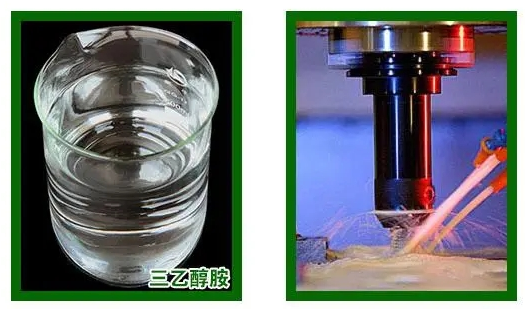
Privacy statement: Your privacy is very important to Us. Our company promises not to disclose your personal information to any external company with out your explicit permission.
2023-08-22
Triethanolamine is an important additive in water-based cutting fluids. Regardless of which cutting fluid is used, triethanolamine is used, indicating the importance of triethanolamine in cutting fluids. However, what role does triethanolamine play in cutting fluids? What are its functions in cutting fluids? Let's talk about the following functions of triethanolamine in cutting fluids.

Triethanolamine itself is a water-soluble rust inhibitor. It can effectively prevent steel from rusting in the short term when used alone, with a general concentration of 0.5% to 2%. Triethanolamine has a synergistic rust prevention effect with water-soluble rust inhibitors such as phenylethanolamine, sodium benzoate, borax, and sodium carbonate. The combined use can significantly improve the rust prevention ability of water-based cutting fluids. However, triethanolamine has a corrosive effect on copper, and adding 0.05% to 0.1% benzotriazole can improve its corrosion resistance to copper. Oleic acid triethanolamine is also a rust inhibitor, which is suitable for rust prevention of ferrous metals and aluminum alloys.
2.3 Surfactants
Surfactants play a role in penetration, diffusion, stability, and cleaning in water-based cutting fluids, and are essential additives for synthesizing cutting fluids and emulsions. Triethanolamine and fatty acids can be used to synthesize an anionic surfactant. Surfactants synthesized with different ratios and fatty acids have different HLB values, which can be suitable for the needs of different water-based cutting fluids. These surfactants have good emulsification ability, and when used in combination with non ionic surfactants such as alkylphenol polyoxyethylene ether or fatty alcohol polyoxyethylene ether, the emulsification effect is better.
Triethanolamine itself is also a non ionic surfactant, and adding it to water can significantly reduce the surface tension of water. Adding triethanolamine to water-based cutting fluid will help the cutting fluid to infiltrate and penetrate the interface being cut (ground), thereby fully utilizing the cooling and cleaning effects of water-based cutting fluid.
2.4 Stabilizers
The oiliness agents, extreme pressure agents, and other additives added to water-based cutting fluids are easily resolved by water, thereby reducing the effectiveness of the cutting fluid. Adding a small amount of triethanolamine can have a stabilizing effect. For example, organic borate esters are a new type of extreme pressure and anti wear agent, which are formed by the reaction of substances with hydroxyl groups with boric acid or its compounds. The main drawback of borate esters is their ease of hydrolysis. Adding a small amount of triethanolamine during the synthesis of borate esters can inhibit hydrolysis.

Share to:
Send Inquiry

Mr. James
Tel:0086-371-58651986
Fax:
Mobile Phone:+8613783582233
Email:sales@cn-lubricantadditive.com
Address:No.11 Changchun Road, High-Tech Zone, Zhengzhou, Henan
Related Products List
Mobile Site


Privacy statement: Your privacy is very important to Us. Our company promises not to disclose your personal information to any external company with out your explicit permission.

Fill in more information so that we can get in touch with you faster
Privacy statement: Your privacy is very important to Us. Our company promises not to disclose your personal information to any external company with out your explicit permission.